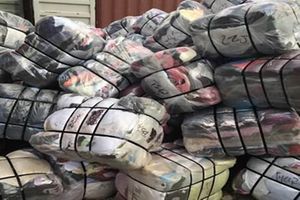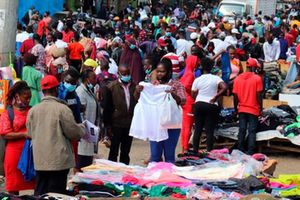
Traders selling second-hand clothes at Gikomba Market in Nairobi on February 18, 2024. In 2023, Kenya led Africa in the importation of used apparel and textiles.
Kenya is now the biggest importer of second-hand clothes in Africa, giving the country the dubious distinction of being an easy dumping ground for used apparel while it struggles to revive its collapsed textile industry.
The latest trade data compiled by the United States-based Massachusetts Institute of Technology (MIT) shows that Kenya imported used clothes and textiles valued at Sh38.5 billion ($298 million) in 2023, overtaking Nigeria, which has a population four-and-a-half times bigger, to become the continent’s leading buyer of mitumba, the Kiswahili reference to second-hand apparel.
The imports marked a 12.45 per cent increase from Sh34.28 billion ($265 million) in 2022, as shiploads of used clothes continued to enter the Kenyan market to meet a rising demand for cheap garments.
Mitumba traders import all categories of used clothes, including underwear, dresses, shirts, trousers, jackets and shoes, while other second-hand textiles such as bedding, towels, curtains, fabric scraps and industrial rags also find their way into the country.
“I think we have not been intentional about growing the textile sector,” said Tobias Alando, the chief executive officer of the Kenya Association of Manufacturers in an interview.
An analysis of MIT’s Observatory of Economic Complexity shows that Kenya’s imports of used clothes and textile articles had been at par with Nigeria’s at Sh34.5 billion ($265 million) in 2022, with South Africa coming third at Sh33.76 billion ($261 million).
South Africa, where the import of second-hand clothing is restricted except for specific purposes like manufacturing industrial wiping rags or donating to registered charities, was the leading importer of used clothes and textiles in 2021.
Like in South Africa, the import of used clothes is prohibited in Nigeria, but they continue to be smuggled into the West African nation from neighbouring countries, analysts say.
The data shows that imports of mitumba and other textiles are almost at par in Kenya, while Ugandans and Tanzanians mostly import used clothes.
Second-largest importer
Ghana was the second-largest importer of used clothes and other textiles in 2023, shipping in mitumba valued at Sh30.4 billion, followed by South Africa (Sh29.4 billion), Uganda (Sh27.2 billion), and Nigeria (Sh27 billion).
Mitumba imports into Kenya are likely to increase further after MPs removed two taxes, Import Declaration Fees (IDF) and the Railway Development Levy (RDL), through the Tax Laws (Amendment) Act, 2024.
Manufacturers have opposed these amendments, even as officials in the Trade ministry disowned them, noting that they were “sneaked” in by lawmakers at the committee stage .
“You are basically making mitumba coming into the country cheaper,” said Mr Alando.
Kenya’s growth in mitumba imports comes at a time when most of its neighbours, including Uganda, Rwanda and Ethiopia, have moved to prohibit the inflow of used clothes into their countries to spur local manufacturing.
To stem imports of second-hand clothes, some countries in the seven-member East African Community (EAC) have increased tariffs, while others have explored incentives for local textile production.
Used clothes imported from outside of the EAC attract a duty rate of 35 per cent or $0.20 per kilogramme, whichever is higher. Countries such as Rwanda increased tariffs on imported used clothes, defying threats of retaliation from the US, one of the leading sources of used clothes.
Some officials in the Ministry of Trade, who requested anonymity to speak freely without fear of reprisals, suspect that most of the mitumba imports are not Kenya’s.
“They are crossing the borders,” said an official.
Matters are made worse given Kenya’s reliance on the African Growth and Opportunity Act (Agoa), a piece of legislation that allows some African countries to access the US market duty-free. To continue enjoying preferential access to the US market under Agoa, especially for textiles, Nairobi has to allow imports of mitumba, a big chunk of which comes from the world’s richest nation.
The decisions by Uganda and Ethiopia to ban imports of mitumba came after they were removed from Agoa.
“We are reviving cotton, and for us to revive it, we have to revisit mitumba. But also the country wants to have Agoa renewed. It is a catch-22,” said Dr Juma Mukhwana, the principal secretary for Trade, Industry and Investment.
Attempts to curb the import of mitumba have sharply divided the country’s policymakers and economists since the country ended its import substitution programme in the early 1990s.
While proponents argue that imported clothes are beneficial for consumers who can’t afford expensive new clothes, opponents argue that it has killed the textile and apparel value chain, which has the potential to create millions of jobs—from the farmers growing cotton to workers in ginneries and salespersons in shops.
In his campaign, former Prime Minister Raila Odinga was forced to swallow his words after he suggested that he would seek to revive the local textile industries.
“Our people are only wearing clothes from outside the country which have been worn by people who are dead. We are going to do primary production so that our people who are importing mitumba can have good products to sell here,” said Mr Odinga.
He was forced to clarify that he did not talk of a ban on mitumba as his political opponents, including William Ruto, who went on to win the presidency, capitalised on the remarks to win over thousands of mitumba traders.
Successive administrations have attempted to revive the textile sector. The Kenya Kwanza government is implementing the “value chain” approach under the Bottom-Up Economic Transformation Agenda, while the Jubilee administration attempted to do so through the “Big Four” Agenda. The initiative have, however, barely dented the market for second-hand clothes.
Kenya has invested heavily in modernising the Eldoret-based Rivatex East Africa, providing it with funding for new equipment and infrastructure.
The company, which recently announced it was seeking a strategic investor, has focused on upgrading its machinery to increase its production capacity so as to meet the growing demand for textiles in Kenya and the region.
The draft National Cotton, Textile, and Apparel (CTA) Policy 2024 is intended to guide the development of the cotton value chain in Kenya.
Competitiveness and sustainability
“The policy seeks to revitalise and enhance the competitiveness and sustainability of the cotton, textile and apparel sector in Kenya and within the region,” said the National Treasury in its 2025 Budget Policy Statement.
As part of its comprehensive strategy for the four years to 2027, the Kenya government intends to revitalise and expand its textile industry, focusing on both value addition and market access.
It intends to establish textile value-addition centres in Nyando and Kieni to improve the quality and processing of raw materials and build seven new ginneries while modernising existing ones.
Under the Fourth Medium-Term Plan, the government will also equip county industrial development centres with tailoring facilities to support local tailors and small businesses.
It will also launch global campaigns to promote Kenyan-made textiles and apparel and identify and address unfair trade practices that threaten the industry.


